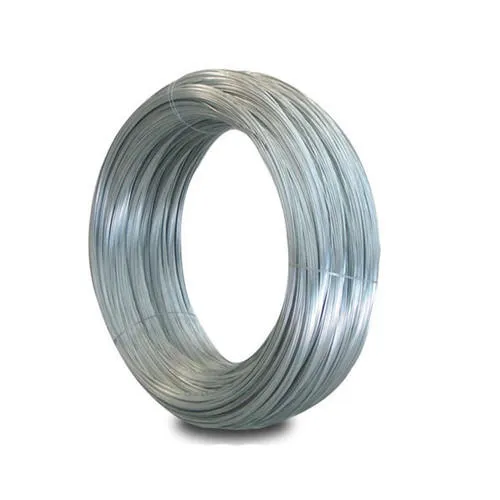Dec. 25, 2024 15:27 Werom nei list
Ferkenne oft galvanisearre draad roest
Galvanized wire is in soad brûkt materiaal yn it deistich libben en yndustry, benammen yn applikaasjes dêr't corrosie ferset en sterkte binne nedich. Lykwols, hoewol galvanisearre tried hat ûndergien spesjale anty-corrosie behanneling, it is net hielendal ymmún foar roest. De anty-corrosie-prestaasjes hinget foaral ôf fan 'e kwaliteit fan galvanisearre coating, applikaasjeomjouwing en eksterne faktoaren. Begryp fan de skaaimerken fan galvanisearre tried is behelpsum om syn libbensdoer te maksimalisearjen en it foarkommen fan roest te ferminderjen.

Sil galvanisearre draad roast?
It antwurd is ja: galvanisearre tried sil rust, mar it is mear corrosie-resistant as gewoane stielen tried of izeren tried. Galvanized wire wurdt bedekt mei sink laach troch galvanizing proses, dat kin soargje poerbêst anti-corrosie beskerming. Sink sels hat in tige sterke korrosjebestriding, wat effektyf kin foarkomme dat focht, soerstof en oare korrosive stoffen yn kontakt komme mei izeren tried, sadat it roestproses fertrage.
Lykwols, galvanisearre tried is net absolút roestfrij. Mei it ferrin fan 'e tiid, benammen yn drege omjouwing, kin de sinklaach stadichoan wearze of degradearje. Sadree't de sink laach is skansearre, de izeren tried hjirûnder wurde bleatsteld en begjinne te reagearjen mei focht en soerstof yn 'e loft, en dan roest sil foarkomme. Dêrom, hoewol't de anty-corrosie effekt fan galvanisearre tried is goed, it kin net hielendal mije roest.
Faktors dy't ynfloed hawwe op roest fan galvanisearre draad
De roest ferset fan galvanisearre tried is net ûnferoarlik, en har roestsnelheid wurdt beynfloede troch in protte faktoaren:
Dikte fan galvanisearre laach
The thickness of galvanized layer directly determines the corrosion resistance of iron wire. Generally speaking, a thicker zinc layer can provide longer protection. In the galvanizing process, it can be divided into two types: "electro-galvanizing" and "hot galvanizing". The zinc layer of hot dip galvanizing is usually thicker, so it has stronger corrosion resistance and longer service life than electro-galvanizing. Thin galvanized layer is easy to be corroded, thus shortening the service life of iron wire.
Environmental conditions
The environment has an important influence on the rust rate of galvanisearre tried. Galvanized wire can maintain its corrosion resistance for a long time in dry or moderately humid environment. However, in coastal areas with plenty of salt water, or areas with high humidity and serious industrial pollution, the galvanized layer will accelerate corrosion and rust obviously. Chloride ions in brine will react with zinc, which will lead to premature failure of zinc layer, and then expose the surface of iron wire, leading to rust.
Mechanical damage
Once the anticorrosion layer of Galvanized Iron Wire for Fencing is physically damaged, the protective effect of zinc layer will be greatly reduced. Scratches, collisions or long-term friction may damage the galvanized layer, exposing the underlying iron wire to the external environment and easily being corroded. Especially in the process of use, the scratch or friction of steel wire may become the starting point of corrosion.
Chemical environment
Acidic or alkaline environment also has adverse effects on galvanisearre tried, especially high concentration of acidic or alkaline gas and liquid, which will accelerate the corrosion of zinc layer and lead to the failure of anticorrosion effect of galvanized iron welded wire mesh. Galvanized wire may corrode in a short time in industrial areas or around factories with serious chemical pollution.
Technically, the future galvanisearre tried may improve its corrosion resistance and mechanical properties through innovative production technology to better meet the high-standard application requirements. At the same time, the environmental protection performance of galvanisearre tried is expected to be further improved, making it an important material that meets the needs of green buildings, green transportation and other industries.
-
How PVC Welded Wire Mesh Enhances Industrial Safety Standards
NijsJul.23,2025
-
Hexagonal Wire Mesh Innovations for Coastal Protection Projects
NijsJul.23,2025
-
Galvanized Wire Fence Maintenance Tips for Harsh Weather Conditions
NijsJul.23,2025
-
Galvanized Steel Grating Applications in Industrial Flooring Solutions
NijsJul.23,2025
-
Energy Absorption Capabilities of Twisted Square Bars in Seismic-Resistant Structures
NijsJul.23,2025
-
Affordable Chain Link Fence Gate Options for Residential Security
NijsJul.23,2025

